|
|
|
|
Welcome to The Storytellers, a monthly newsletter of outstanding children’s literature to read and read aloud from preschoolers to teens.
Summer is here. Warm weather and a relaxed environment is great time to read
or listen to great stories. We hope you enjoy our choices below, especially for road trips, warm evenings in the backyard, and anywhere else in between.
The books featured represent some of the best of imagination and fun in children's literature and are presented for reading and listening enjoyment.
For more information on reading to children and great books to read and read aloud, log on to our web site at
www.tchliteracy.com.
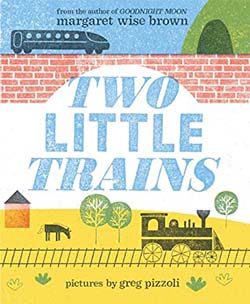
TWO LITTLE TRAINS
written by Margaret Wise Brown, illus by Greg Pizzoli, (HarperCollins, $17.99, March 2020, ISBN 978-0-06-267651-1), 40p, Ages 3-6
“Two little trains / went down the track, / two little trains went West. // PUFF PUFF PUFF / CHUG CHUG CHUG / two little trains to the West.” Originally written in 1949, this classic adventure, by the late Margaret Wise Brown and newly illustrated by Greg Pizzoli, follows two different trains, one streamlined and one much older, as they wind their way to the West in tandem.
Their journey takes them through tunnels, over bridges, across mountains, and past valleys as they encounter rain, snow, and hot baking sun to finally arrive in the West, with its blue ocean, deserts of cactus, and big cities. Children will love this simple, rhythmic journey of two determined trains puffing and chugging their way across America.
Themes: Adventure, Classics, Nature, Transportation
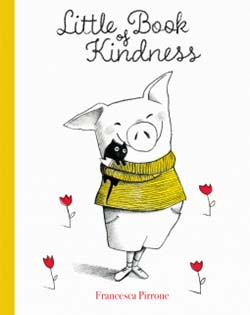
LITTLE BOOK OF KINDNESS
written/illus. by Franesca Pirrone, (Clavis Publishing, $11.95, June 2020, ISBN 978-1605375335), 50p, Ages 3-6
Kindness is easy when it comes from the heart, as shown by a little pig, who finds solutions to various problems. He helps pick up toys for his friend mouse, offers a smile to a discouraged bunny, and builds a bird house for a cold little bird. Simple acts of random kindness (saying thank you, offering a smile, being patient, helping others, nurturing nature, protecting the environment, rescuing the innocent, sharing, cleaning up) can do wonders for small children who are leaning that kindness can make a difference.
Themes: Adventure, Animals, Heroes, Values
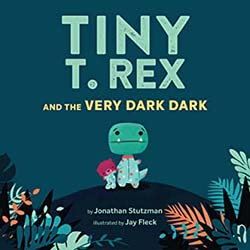
TINY T. REX AND THE VERY DARK DARK
written by Jonathan Stutzman, illus. by Jay Fleck, (Chronicle Books, $15.99, March 2020, ISBN 978-1-4521-7034-3), 48p, Ages 3-5
Camping out in the backyard sounds like fun to Tiny T. Rex and his stegosaurus friend Pointy, but the dark seems scary and there are no nighty-lights outside to scare away the Grumbles, Nom-bies, and the Crawly-creeps. According to mom, “There’s always a light shining somewhere, Tiny. Even in the dark. If you are brave and look hard enough, you will find it.”
They try building a fort, wearing special helmets for protection, and stringing lights, but nothing vanquishes the dark, until they discover the best nighty-lights of all when they look up in the sky. With plenty of humor and warmth, this adventure about friendship, determination, and parents’ words of wisdom, will prove that the dark is thoroughly conquerable.
Themes: Adventure, Dinosaurs, Friendship, Series
Other book in the Series: Tiny T. Rex and the Impossible Hug
|
| |
| |
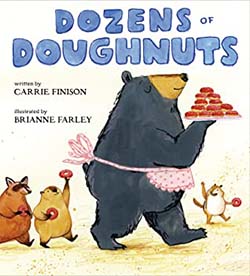
DOZENS OF DOUGHNUTS
written by Carrie Finison, illus. by Brianne Farley, (G.P. Putnam’s Sons, $16.99, July 2020, ISBN
978-0-525-51835-8), 40p, Ages 3-7
“Early one morning, as autumn leaves scatter. / LouAnn’s busy stirring a big bowl of batter. / She’ll eat some sweet treats, then, warm and well-fed. / she’ll sleep away winter, tucked tight in her bed.” Her pre-hibernation plans suddenly change with a “DING-DONG!” and the arrival of one friend after another asking to share her doughnuts. Kind-hearted LouAnn graciously cooks up and divides each batch of a dozen doughnuts with friends. There’s Woodrow the woodchuck, then Clyde the raccoon, Topsy the opossum, Mouffette the skunk, and twin squirrels Chip and Chomp.
With winter approaching, a rumbling tummy, a messy kitchen, and nothing left to eat, LouAnn makes her frustration known with a loud “ROAR!” Wisely, the friends apologize and make amends by bringing ingredients to cook doughnuts for a very sleepy bear. Kids will enjoy this rhyming tale of kindness, generosity, and friendship. Adults will appreciate the subtle mathematics. Endpapers contain the names and illustrations of 24 types of donuts to drool over.
Themes: Animals, Bears, Food, Friendship, Humor, Rhythm & Rhyme
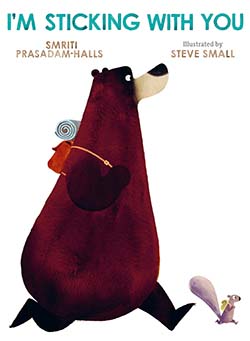
I’M STICKING WITH YOU
written by Smriti Prasadam-Halls, illus. by Steve Small, (Henry Holt & Co., $18.99, May 2020, ISBN
978-250-61923-5), 40p, Ages 4-8
“Wherever you’re going, / I’m going too. / Whatever you’re doing. / I’m sticking with you” Although different in character, size, and interests, that doesn’t stop Bear and Squirrel from being inseparable friends . . or so it seems. Although Bear vows to stick together with Squirrel through good and bad times, their relationship is put to the test, when he accidentally breaks Squirrel’s beautiful teacup, launches Squirrel skyward off the seesaw, sneezes Squirrel’s tree house to pieces, and sinks Squirrel’s canoe.
When Squirrel decides that he needs some time by himself, Bear agrees and departs reluctantly. But sometimes it takes a little time apart to realize how much we need our friends. Missing Bear terribly Squirrel declares, “Well pick up the pieces, / we’ll patch up the hole. / We’ll mend what needs fixing, / because that’s how we roll.” This charming story about friendship, loyalty, and love will touch and warm all hearts who listen to its lesson. The illustrations are priceless.
Themes: Animals, Friendship, Humor, Rhythm & Rhyme, Values
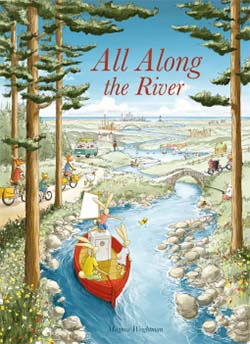
ALL ALONG THE RIVER
written /illus. by Magnus Weightman, (Clavis, $17.95, May 2020, ISBN
978-1605375182), 32p, Ages 4-8
Join a delightful river adventure of a little bunny in search of her beloved toy, which accidentally floated away down the local river. From her mountaintop home Bunny Rabbit and her brothers grab their boat and travel the river through green valleys and forests, past farms, over lakes, down a waterfall, and past factories and windmills to the ocean in search of Little Duck.
Along the way they meet other characters with adventures of their own (Chuck the roller-skating chicken, Road Hogs the motorcycle racing pigs), which will necessitate repeat readings to answer questions found at the beginning of the tale. The final double page shows the animals admiring a schematic of the explored route, along with a little snail asking, “Did you see me?” Originally published in the Netherlands and Belgium, kids will enjoy each page of complex details and character stories in this clever seek-and-find adventure of a lost-and-found toy.
Themes: Adventure, Animals, Heroes, Toys
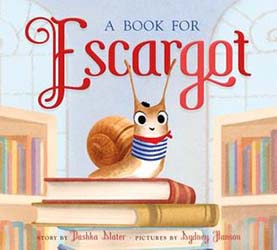
A BOOK FOR ESCARGOT
written by Dashka Slater, illus. by Sydney Hanson, (Farrar Straus Giroux, $16.99, April 2020, ISBN 978-0-374-32186-2), 40p, Ages 4-7
The charming French snail from Escargot (2017) returns for an adventure at the library, where he hopes to find a French cookbook on how to cook green beans, souffles, ratatouille, and French fries (He is tired of eating salads), and longs to create stories about snail superheroes. When Escargot finds The Art of French Cooking, he discovers that snails are on the menus. Declaring that, “Nobody will be learning how to cook me!” Escargot decides to defeat the dangerous recipes by eating the cookbook and helps the reader write his story.
Kids will love Escargot’s favorite books: Goodnight Snail, Where the Wild Snails Are, The Very Hungry Snail, Harry Gastro Podder and the Chamber of Salads, Goldytentacles and the Three Snails.
Themes: Adventure, Animals, Humor, Series
|
| |
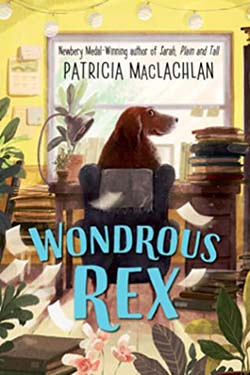
WONDROUS REX
written by Patricia MacLachlan, illus. by Emilia Dzubiak, (Katherine Tegen Books, $15.99, March 2020, ISBN
978-0-06-294098-8), 96p, Ages 7-10
Rex, a wonder or wonders, shows up one day in answer to an ad placed by 7-year-old Grace’s Aunt Lily: “A writer of books needs an assistant, a coach, a helper, for inspiration and some magic!” Magic does indeed begin when Maxwell the Magician brings Rex, a Labrador retriever, into their lives. It seems that Max is bored, sad, and needs new work.
Max begins to pull up famous quotes on the computer to share with Aunt Lilly (“If you find a book you really want to read but it hasn’t been written yet, then you must write it” – Tony Morrison). He organizes her office, gathers up the laundry, gives marvelous hugs, types out a few thoughts of his own (“Dogs know secrets. Dogs keep secrets.”) and inspires confidence and creativity in the lives of a burned-out writer and a young girl searching for her own story.
Magical, whimsical, and altogether delightful, readers and listeners will enjoy this gentle retriever’s love, protection, notes of wisdom, and Lucy-Lou, the chicken.
Themes: Animals, Families, Heroes, Humor, Pets
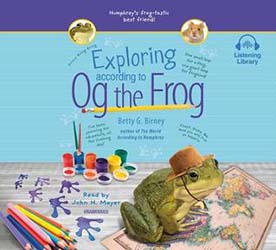
EXPLORING ACCORDING TO OG THE FROG
written by Betty G. Birney, (G. P. Putnam’s Sons, 2019), 144p,
Ages 8-11
This second book in the Og the Frog series finds Og on a mission to explore the world of humans. Along the way he discovers adventure, bravery, taking risks, and helping others. His permanent home is now in Room 26 at Longfellow School, where he and his friend, Humphrey the hamster, watch the students from their cages. Og enjoys encouraging the struggling students with his “Boing, Boing” and yearns to make an impact on their lives. Between helping the children and attempting to hop from his tank, Og spends a few weekends with the Principal and his family, helping to sooth a sibling rivalry problem.
Interspersed throughout the book are his Granny Greenleaf’s witty sayings (“Whatever you do, wherever you are, make the most of your time, and you’ll go far!”), Uncle Chinwag’s tales, and Og’s poems set to familiar melodies found on the endpapers. Kids will love Og’s tales of McKenzie Marsh.
Friendship, Pets, Series
|
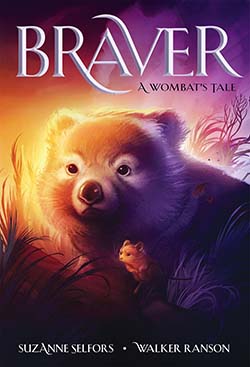
BRAVER: A Wombat’s Tale
written by Suzanne Selfors / Walker Ranson, (Imprint, Macmillan Publishing, $16.99, June 2020, ISBN
978-1-250-21991-6). 288p, Ages 9-13
“Gather ye round and prick your ears, for a tale is about to be told.” Readers and listeners will thoroughly enjoy this epic tale of a young Australian wombat, a fastidious swamp water rat, and an adorable clueless baby penguin, who join together on a journey to save the wombats of the Northern Forest and rescue their queen.
Lola Budge may look like an average bare-nosed wombat, but her love for conversation, stories, adventure, and helping others set her apart from most wombats. Unhappy with her quiet, stable life, Lola sneaks out of her burrow and by accident meets a messenger platypus, who delivers a secret message, “T.B is ready”. Puzzled by its meaning, Lola returns to the village to discover that Tassie Devils have captured the village of wombats, including her family. With Her mother’s last words, “Find your uncle, He’ll know what to do,” she begins a hero’s journey to the royal city of Dore to rescue them. Joined by Melvin, a well-groomed swamp rat that sells beauty products, and Blue, a rescued baby penguin, Lola begins a dangerous journey of infested swamps, evil predators, royal corruption, family traitors, and unexpected friendships, because she knows, “The best stories come with the least expected heroes.”
Adults will appreciate the warning in the credits: “Proclamation from the Royal Librarian of Dore: All creatures take heed, / A warning indeed, / Whether feather or fur, / Web-footed or spur, / If you steal a book / The predators will look, / FOR YOU.” Kids will enjoy this destined-to-be-a-classic, with its adorable little Blue, the one-winged firehawk that flies a hot-air balloon, and the laugh-out-loud dialogue.
Themes: Adventure, Animals, Families, Friendship, Humor
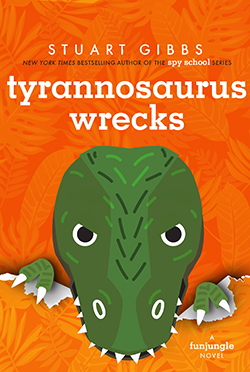
TYRANNOSAURUS WRECKS (Fun Jungle Series)
written by Stuart Gibbs, (Simon & Schuster Books for Young Readers, $17.99, March 2020, ISBN
978-1-5344-4375-4), 336p, Ages 10-13
Fans of Stuart Gibbs’ Fun Jungle series will love his latest mystery/adventure surrounding a missing 65-million-year-old, 500-pound Tyrannosaurus skull, the black-market reptile trade, Zebra Spankers, inept authorities, and wild high-speed chases.
Determined not to become involved in more dangerous investigations, 13-year-old Teddy Fitzroy has a change of heart, when his best friend, Sage, asks for help in locating a Tyrannosaurus skull recently discovered on his family’s ranch. In addition to finding the fossil thieves, Teddy investigates an illegal reptile business that the bully Barksdale brothers are involved with. Seems that they obtained an illegal 15-foot anaconda which ate their cat, and they not only want the cat back, but want Teddy to find their newest acquisition (a cobra) which is missing in their house.
Readers will enjoy the fun, chaos, and high-speed chases, as well as the endpapers that discuss the illegal enterprise of animal trafficking.
Themes: Adventure, Friendship, Humor, Mysteries, Series
Others in the Series: Belly Up | Big Game | Poached | Panda-monium | Lion Down
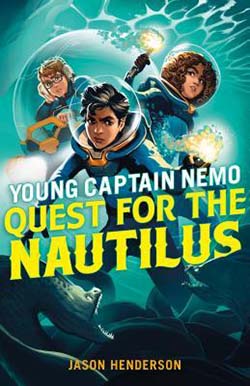
THE QUEST FOR THE NAUTILUS #2 (Young Captain Nemo)
written by Jason Henderson, (Feiwel and Friends, $17.99, March 2020,
ISBN 978-1-250-17324-9), 304p, Ages 10+10-13
This second action-packed underwater adventure from Young Captain Nemo (2019), finds twelve-year-old Gabriel Nemo, descendent of the famous Jules Verne’s character, Captain Nemo, and his companions racing to rescue his kidnapped mother.
When the kidnappers demand a valuable artifact in exchange for releasing Gabriel’s mother, they begin to search for the Dakkar’s Eye, a source of endless power, which resides on Captain Nemo’s famous ship, the Nautius, lost in 1910. To find the missing wreckage, they must swipe the Captain Nemo’s lost journal, currently residing on the USS Alaska, decipher the code, which should lead them to the ship. But adventures have a way of becoming complicated, especially when racing against the kidnappers’ hundred-hour deadline.
Readers will love this page-turning, sci-fi adventure, full of suspense and intrigue, seafaring technology, family values, and three remarkable young heroes.
Themes: Adventure, Families, Friendship, Heroes, Motoring On, Science Fiction, Series
|
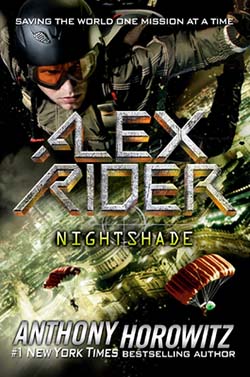
NIGHTSHADE (Alex Rider series)
written by Anthony Horowitz, (Philomel Books, $17.99, April 2020,
ISBN 978-0-593-11531-2), 432p, Ages 12-15
This 12th installment in the Alex Rider series finds Alex hoping to return to a normal life in London after destroying the evil organization Scorpia. Circumstances change when the Head of Special Operations tries to recruit Alex to help stop a terrorist plot in London by a criminal organization called Nightshade. Alex is reluctant until Mrs. Jones reveals her personal connection to the situation.
Assuming the identity of his now-dead nemesis, Julius Grief, Alex’s mission is to infiltrate a prison in Gibraltar, bond with a young incarcerated Nightshade assassin, and infiltrate Nightshade’s organization. After a daring escape with Freddy to Nightshade headquarters on Crete, Alex discovers 25 children like Freddy, who have been brainwashed by Nightshade. From Gibraltar to Greece to London, readers will root for Alex as he tries to stop the most lethal attack on London in British history on his own.
Themes: Adventure, Heroes, Mysteries, Suspense, Series
Others in the Series: Stormbreaker | Point Blank | Skeleton Key | Eagle Strike | Scorpia | Ark Angel | Snakehead | Crocodile Tears | Scorpia Rising | Russian Roulette | Never Say Die
|
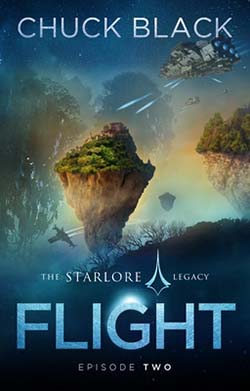
FLIGHT #2 (The Starlore Legacy)
written by Chuck Black, illus. by Elena Karoumpali/Reese Black, (Perfect Praise Publishing, HC $24.99, PB 11.99, May 2020, ISBN 978-0-9915735-2-3), 262p, Ages 16+
The Starlore Legacy continues, as young Daeson Starlore (NOVA 2019) seeks the oracle Sabella, who turned his life upside down with a strange prophesy. “Royal blood flows through your veins, but you are not who you think you are. Soon there is coming a day when the façade of your life will be discovered. You are set apart to turn sorrow into joy for many people and joy into sorrow for many more. Your struggle will be long and painful, but do not be afraid. Sovereign Ell Yon will guide you and protect you.”
With thousands of Rayleans under persecution and the Chancellor seeking his death, Daeson navigates his Starcraft to the dangerous floating islands where the oracle lives, and discovers that his destiny lies with two powerful Immortals, and he must choose which one to follow.
With the destiny of his people hanging in the balance, find out if Daeson can conquer his deepest fears, fight for the future of his people as well as the entire galaxy, and face the wrath of a powerful tyrant and the dark Lord. Readers will enjoy this sci-fi space thriller and Biblical allegory, with its space-tech gadgets, and marvelous illustrations of Conduit Gateways, futuristic spacecraft, and the Android Robot Rivet.
Themes: Adventure, Heroes, Mysteries, Science Fiction
|
StoryKeepers
Stories from the Past to Read, Share, and Treasure
|
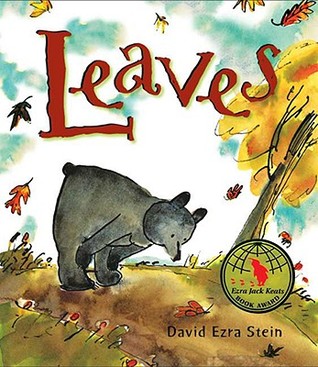
LEAVES
written/illus. by David Ezra Stein, (G.P. Putnam's Sons Books for Young Readers, 2007, ISBN 978-0399246364), 32p, Ages 2-5
Its autumn in a young bear’s first year of life. Upon noticing that the leaves on the trees are falling to the ground all around him, he wonders if the leaves are okay. "He tried to catch them and put them back on . . . but it was not the same." While pondering the situation, he grows sleepy, finds a cave, and goes to sleep. When spring arrives, a much bigger bear emerges from the cave, greets the sunshine, joyfully welcomes the tiny buds on the trees, and believes that the leaves welcome him also. Young ones will enjoy this short, simple, and sweet story of discovering the beauty of nature.
Themes: Animals, Nature, Seasons
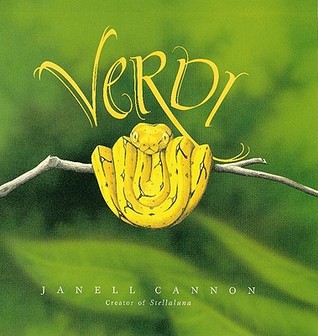
VERDI
written/illus. by Janell Cannon, (Harcourt Brace & Co., 1997), 48p, Ages 4-10
Verdi’s mother explains that someday he will grow up big and green like other pythons. However, Verdi enjoys being yellow and zipping through the forest. Who wants to grow up and become lazy, boring, and rude like the big pythons? One day, while recovering from a flying accident, Verdi realizes that he is now permanently green. Realizing the impossibility of stopping the aging process, he accepts who he is— the same old fun-loving, high-flying Verdi.
Themes: Animals, Nature, Series
Other Books in the Series: Pinduli | Crickwing | Stellaluna
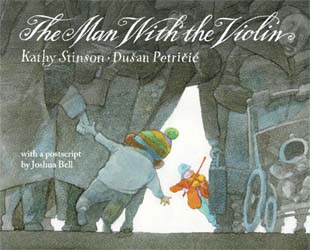
THE MAN WITH THE VIOLIN
written by Kathy Stinson, illus. by Dušan Petričić, (Annick Press,2013), 32p, Ages 5-8
In January of 2007, Joshua Bell, a talented violinist, took part in an experiment at the L’Enfant Plaza Station in Washington D.C. by playing his precious Stradivarius. Over 1,000 people passed by, but very few listened. As a small boy rushes through the station with his mother, he notices a man in a blue baseball cap playing beautiful music. “All the notes swirl and sweep around the blur of people rushing here and rushing there. The music is telling an exciting story. It makes the hairs on the back of Dylan’s neck tickle.”
Too busy to listen, mom pulls him through the station, but the music’s power remains with Dylan. That night mom realizes the missed opportunity as a radio announcer explains the experiment and plays Joshua Bell’s memorable music. A short biography of Joshua Bell, the story behind the book, and a postscript by Bell add to the enjoyment of a lesson in pausing to appreciate life.
Themes: Families, Famous People
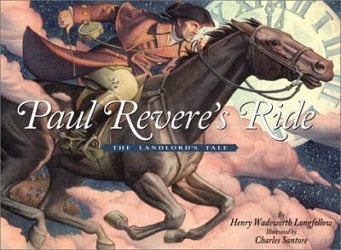
PAUL REVERE’S RIDE: The Landlord’s Tale
written by Henry Wadsworth Longfellow, illus. by Charles Santore, (HarperCollins, 2003), 40p, Ages 8-11
“Listen, my children, and you shall hear / Of the midnight ride of Paul Revere, / On the eighteenth of April, in Seventy-five; / Hardly a man is now alive / Who remembers that famous day and year.” So begins Longfellow’s Revolutionary war poem of Paul Revere’s famous ride, to prepare Colonial villages to take up the battle cry for American independence and arm themselves against the arrival of the British.
A signal light from the old North Church alerts Paul Revere to begin his dramatic horseback ride across the Colonial landscape. One can almost hear the thundering hoofs of Paul Revere’s horse as they cross over village cobblestones and bridges. “In the darkness and peril and need, / the people will waken and listen to hear / The hurrying hoof-beats of that steed, / And the midnight message of Paul Revere.”
Narrated by the landlord of the Wayside Inn, this story-within-a-story is an exciting tale of adventure, courage, and patriotism. Charles Santore’s marvelous illustrations bring to life the urgency of this race against time that no one should miss.
Themes: Adventure, Classics, Heroes, Historical Fiction
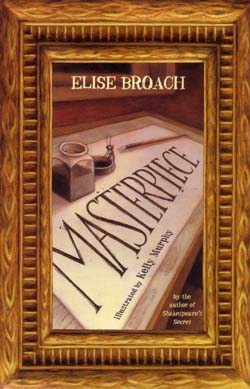
MASTERPIECE
written by Elise Broach, illus. by Kelly Murphy, (Henry Holt and Co., 2008), 320p, Ages 9-13
“A great friendship was like a great work of art he thought. It took time and attention, and a spark of something that was impossible to describe. It was a happy, lucky accident, finding some kindred part of yourself in a total stranger.”
From a gifted storyteller comes a powerful tale of an unlikely friendship between an eleven-year-old boy and a small beetle. James lives in a New York apartment with his social climbing mother and her new family. Marvin and his family reside behind the kitchen sink. The two form a bond when James’ father gives him a pen and ink set as a birthday gift, and Marvin sketches the landscape outside of James window and presents it to him as a birthday gift.
Misunderstandings arise when James’ family believes him to be the artist, Matters escalate when James is recruited to help catch a thief by creating a replica of a famous drawing for the Metropolitan Museum of Art. Marvin reproduces the drawing, but the original masterpiece is stolen. Surprises, mystery, intrigue, art history, family dynamics, and an endearing friendship combine to thoroughly entertain the most reluctant reader and listener.
Themes: Fantasy, Friendship, Insects, Mysteries
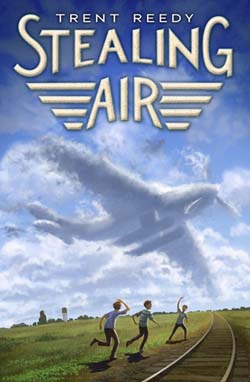
STEALING AIR
written by Trent Reedy, (Scholastic Press, $16.99, ISBN
978-0-545-38307-3), 288p, Ages 9-12
Kids who love middle grade action, adventure, humor (pigout eating contests), old-fashioned ingenuity, skateboarding, and secret labs, will enjoy how three creative sixth grade boys steal air and fly. Brian, new to Riverside, Iowa and a dynamic skateboarder, Max, an inventor and Star Trek nerd, and Alex, a budding entrepreneur, team up to save a struggling family business. They construct an experimental airplane, risk their lives flying without safety precautions, and teach a bully to behave. Kids interested in amateur aviation, challenges, overcoming odds, the enjoyment of success, and just deserts for bullies will love this treat.
Themes: Adventure, Friendship, Humor, Transportation

PROJEKT 1065: A Novel of World War II
written by Alan Gratz, (Scholastic Press, 2016), 320p, Ages 12+
In 1943 Michael O’Shaunessey, 13-year-old son of the Irish ambassador to Germany, becomes a spy for the Allies during World War II. With his flawless German and photographic memory, Michael joins the Hitler Youth to infiltrate Nazi hierarchy and access information that will assist his parents in spying for the Allies.
When Michael rescues a downed British pilot, he is alerted to the existence of Projekt 1065, a new Nazi warplane with no propellers. Upon discovering that his classmate’s father is the designer of the plane, Michael obtains access to the blueprints. In a complex coming-of-age drama of friendship, loyalty, espionage, and betrayal, Michael experiences tough choices and moral dilemmas
The author’s note gives background information on the Hitler Youth organization, Nazi’s use of children to fight the war, their rehabilitation after the war, the real Projekt 1065, Operation Paperclip, the Manhattan Project, and Ireland’s neutrality. Kids will find themselves on the edge of their seats in this action-packed adventure.
Themes: Adventure, Families, Heroes, Historical Fiction, Mysteries, Suspense
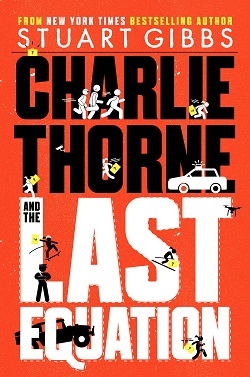
CHARLIE THORNE AND THE LAST EQUATION #1
written by Stuart Gibbs, (Simon and Schuster Books for Young Readers, $17.99, Sept. 2019, ISBN
978-1-5344-2476-0), 400p, Ages 12-15
According to Albert Einstein, “The world is a dangerous place to live, not because of the people who are evil, but because of the people who don’t do anything about it.”
12-year-old Charlie Thorne is highly athletic, a daredevil, an admirer of Albert Einstein, and an extremely intelligent tween with the ability to solve crimes that bewilder adults. She is also capable of stealing 40 million dollars from a tech firm. When Charlie is kidnapped by two CIA agents, she is manipulated into helping them locate Pandora, a complex equation created by Albert Einstein and hidden in the 1930’s somewhere in the world. Thus, begins an adventure around the globe, to locate and solve a mystery code that could create clean energy as well as a weapon of mass destruction.
Defying foreign agents, world powers, and evil organizations, Charlie begins to question not only the motivations of everyone involved, but whether Pandora should ever come to light. From the ski slopes of Colorado to the tundra of Greenland, to the secret tunnels underneath Jerusalem, to the Hubble laboratory in California, readers will enjoy puzzles on top of puzzles, breakneck chases, lessons on cryptography, Einstein, and a bit of history.
Themes: Adventure, Families, Heroes, Historical Fiction, Mysteries, Series
|
|
Over the years, we have researched thousands of children's books, and can recommend some of the best in outstanding children's literature for parents to read aloud and children to read.
Our recommendations must meet certain criteria: fun, creative and imaginative stories, delightful illustrations, and excellent for age appropriate listening and reading. We hope that you enjoyed our recommendations. If you desire further information some of the best in children's literature, please visit our website, www.tchliteracy.com.
CONTACT US:
The Children's Hour
2779 S Church St #309
Burlington, NC 27215
Email: info@tchliteracy.com |
|
|
|
|
|
|